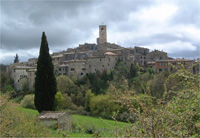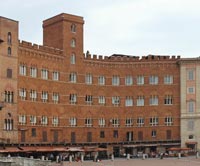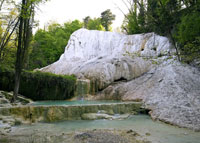Bagno Vignoni |
| The ancient village of Bagno Vignoni is located in the heart of Tuscany, in the Val d'Orcia Natural Park. Thanks to the Via Francigena (which was the main route followed by pilgrims in antiquity who went to Rome), these thermal waters were found and have been used since Roman times. At the heart of the village is the "Square of sources", namely a rectangular tank, of 16th-century origin, which contains the original source of water that comes from the underground aquifer of volcanic origins. Since the Etruscans and Romans - as evidenced by the numerous archaeological finds - the spa of Bagno Vignoni was attended by eminent personalities such as Pope Pius II, Santa Caterina da Siena, Lorenzo the Magnificent and many other artists who had elected the village as main holiday resort. Characteristic of Bagno Vignoni, besides the thermal waters, are its structure, despite numerous incidents of war, devastation and fires that involved the Val d'Orcia in the Middle Ages, remains essentially unchanged since then. From Bagno Vignoni, you can easily reach the historical centers of nearby Pienza and Montalcino, and the general Val d'Orcia area, including the Park of Mount Amiata. The name of this ancient village derives from Vignoni, a famous castle already existing in the 11th century, whose ruins are located on a hill overlooking the village. It is renowned for its thermal waters, already used in Roman times, as testified by a large number of archaeological findings included in the Chigi Collection in Siena, National Archaeological Museum. During the 13th century, the "Bagno" was subjected to the Tignosi Family, lords of Tintinnano, now called Rocca d' Orcia, and it remained under their lordship until the end of the 13th century; in the early 14th century, Bagno Vignoni and the surrounding villages and castles passed into the hands of the Salimbeni family from Siena that owned them until 1417, when Antonia Salimbeni's second husband, Attendolo Sforza, sold the family's properties to the municipality of Siena. Despite countless battles, pillaging, and fires that devastated the Val d'Orcia during the Middle Ages, the village of Bagno Vignoni has remained essentially unchanged in its urban structure and appearance until today. The village developed on a stretch of flat land, surrounded on one side by the Vignoni hill and on the other by the steep gorge of the river Orcia, around a large rectangular pool containing spring water that surfaced from the ground. This structure, which influenced the layout of the entire village and is still at its center, is reminiscent of some typical features of Roman thermal establishments. Houses and inns were built around the pool, as well as the Church of Saint John the Baptist, which holds a restored fragment of a fresco depicting the resurrected Christ, attributed to Ventura Salimbeni and previously preserved in Saint Catherine's Chapel. The waters flowed out of the pool, past a bridge with porticoes, reached the baths and then powered a series of watermills located on the steep hillside sloping down towards the river. Tourists can now visit these ancient mills thanks to a thorough restoration of the area, recently carried out by the Municipality of San Quirico d'Orcia (Watermills Park). |
 |
Bagno Vignoni, Parco dei Mulini [1] |
It is a known fact that Catherine from Siena was taken to Bagno Vignoni numerous times by her mother, who hoped to dissuade her from becoming a nun. Several other famous personalities came here, further proof of the baths' great fame, such as Pope Pius II Piccolomini and Lorenzo De Medici, who sojourned in Bagno Vignoni for a while in 1490. Thanks to the proximity of the village to the Via Francigena, the main road pilgrims traveled on to go to Rome, many travelers came to the baths and those who had time to stop could enjoy the therapeutic properties of the local waters, as testified, for instance, by Michel de Montaigne's travel diary written in 1581. In the 16th century, the waters and their therapeutic properties inspired Lattanzio Tolomei, a scholar from Siena, who wrote an inscription dedicated to the Nymphs with verses in Greek carved on a plaque, which is still visible today along one of Saint Catherine's loggias. The Municipality of Siena always took a great interest in regulating the way in which thermal cures were organized throughout the area and two paragraphs of the Statute of the Town are dedicated to the Vignoni Baths. They prescribe the separation of men's baths from those for women, to be carried out both by the residents of the village and by the people living in the castles of the Val d'Orcia; the document also sets the price of rooms to let. Many scholars took an interest in the mineral waters and the baths and began to study them: among the authors who mention Bagno Vignoni is the physician Andrea Bacci, who stayed in the village in 1548 and praised the generous hospitality of his host family, the Amerighis. In 1592, the Grand Duke granted the Amerighi family the tallage on the baths, under obligation to take care of the facility's upkeep and necessary repairs. In 1599, the agreement became permanent but the family had to provide the Baths with a baker's, a butcher's, an inn, and the necessary personnel to administer the thermal treatments, while in order to carry out the yearly draining of the pool, to be performed in May, the Amerighis could avail of the inhabitants of Val d'Orcia. The Amerighis also built a small chapel dedicated to Saint Catherine, located at the center of the loggia that overlooks the large thermal pool. In 1677 Grand Duke Cosimo III De Medici gave Cardinal Flavio Chigi San Quirico d'Orcia as a feud, together with the small villages of Vignoni and Bagno Vignoni, so that the baths together with three mills, eight houses, an inn, and a number of fields became the property of the Chigi family, whose descendants still partially own them. Tuscany | Bagno Vignoni |
Podere Santa Pia |
Podere Santa Pia |
Rocca di Tentennano |
||
Pienza |
Montalcino |
San Casciano dei Bagni |
||
Siena, Palazzo Sansedoni |
Abbazia di Sant' Antimo, between Montalcino and Podere Santa Pia
|
Bagno San Filippo |
||
The best hiking trails around Bagno Vignoni
|
||||
|
||||
| [Source image: www.quotazero.com] | ||||
